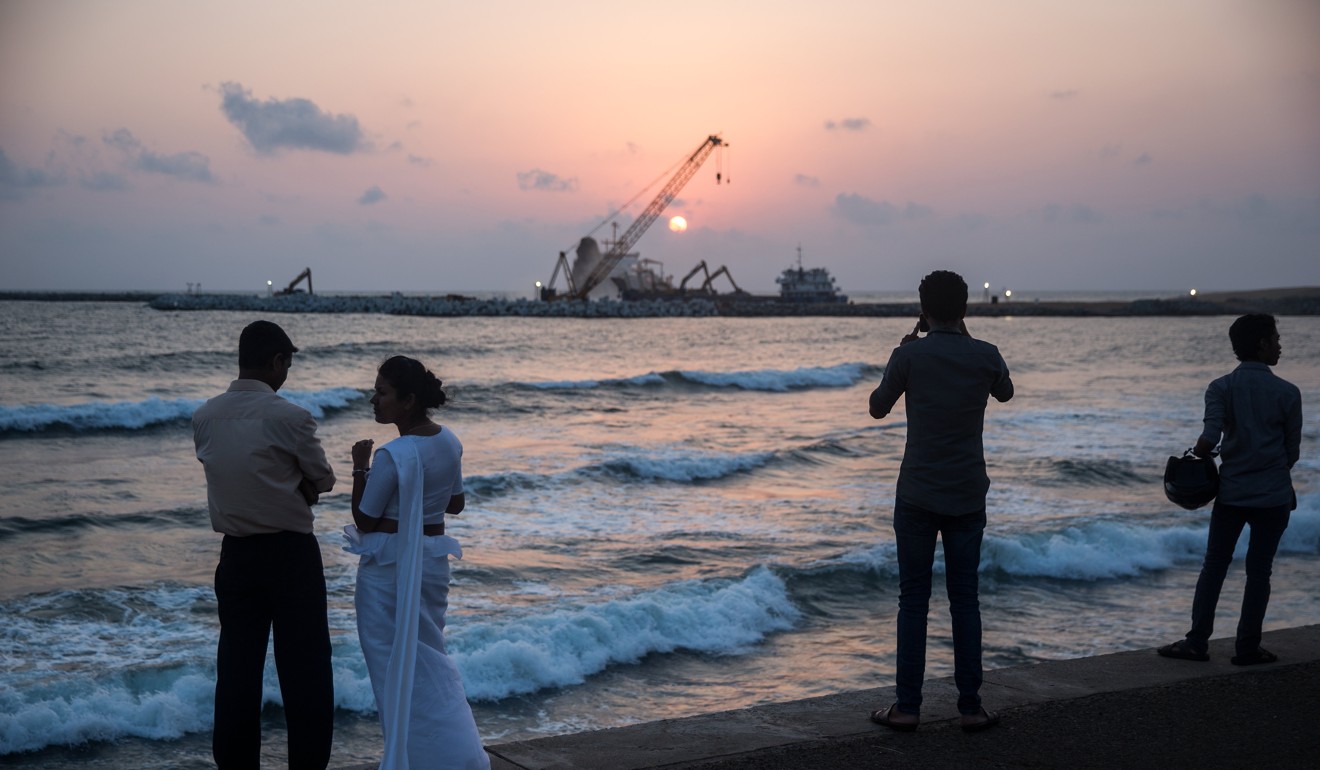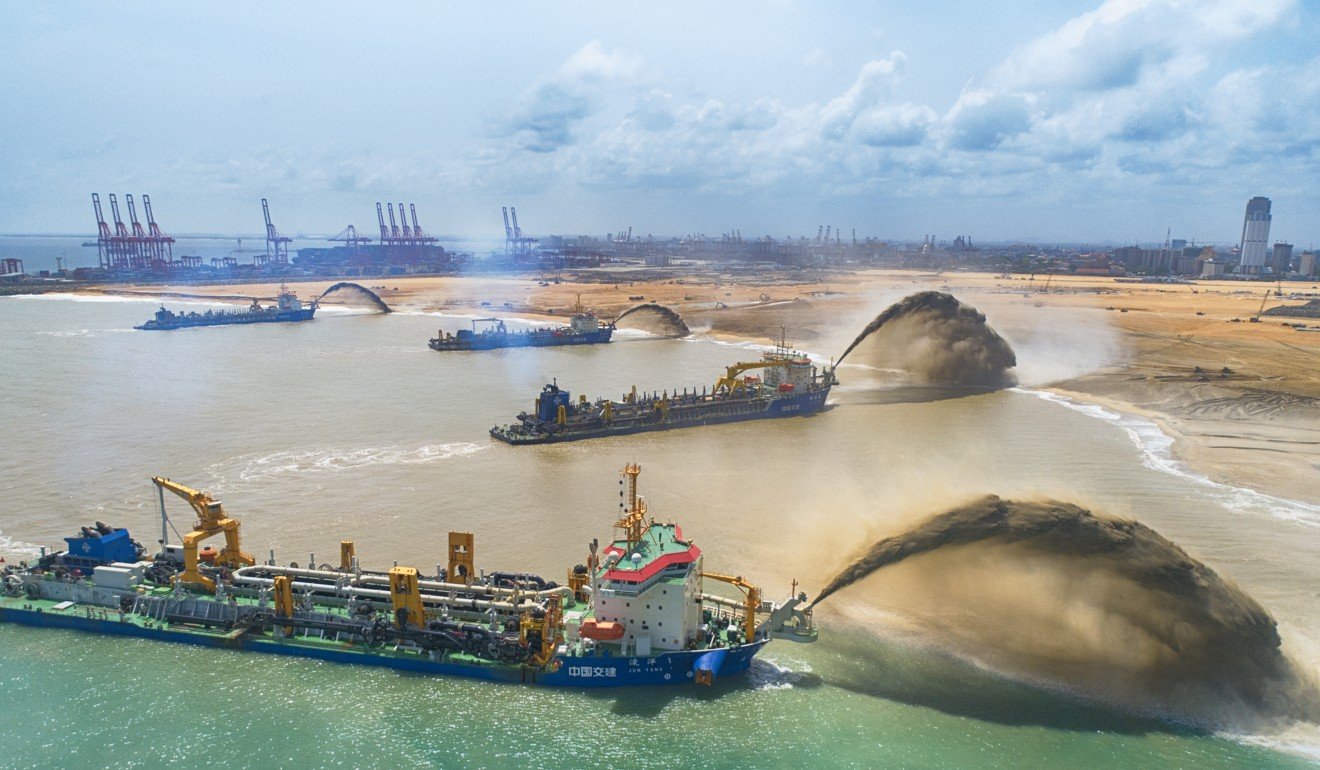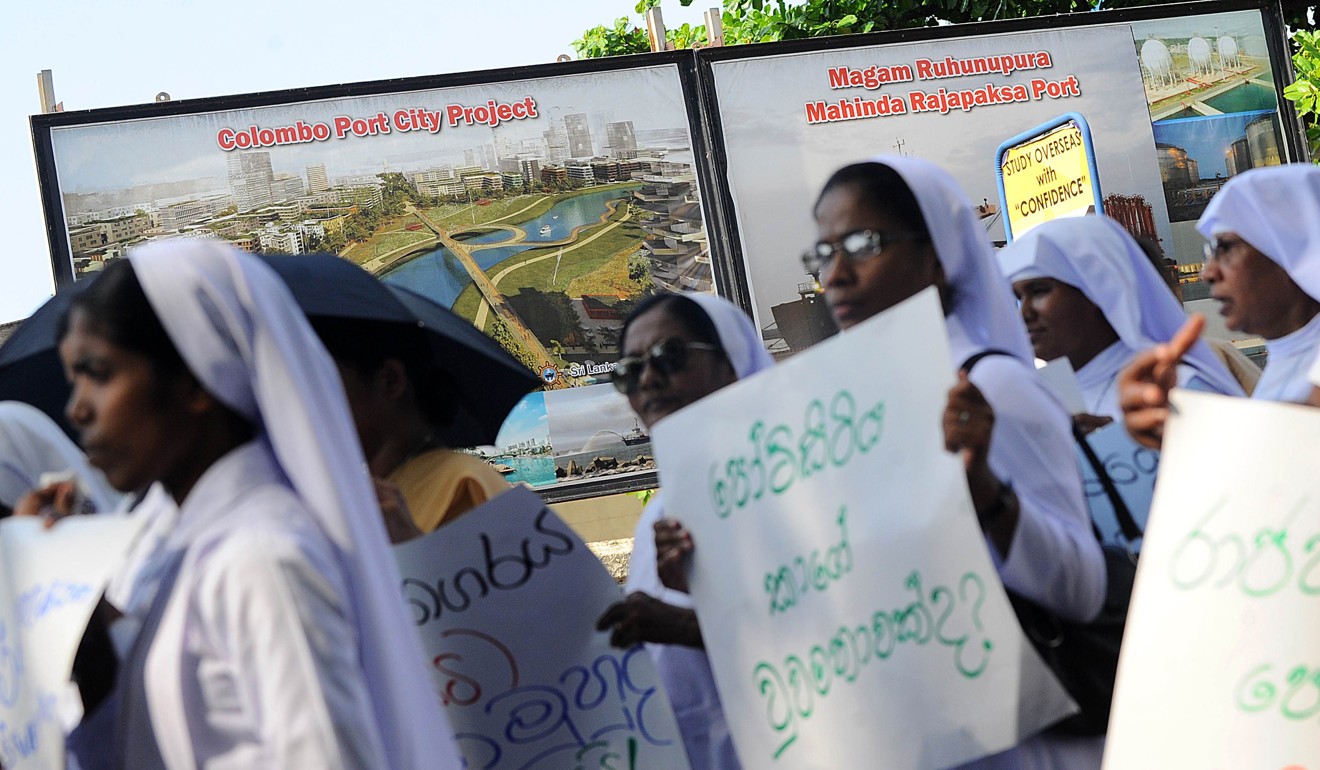- The building of a Hong Kong-style metropolis on reclaimed land in Colombo using US$1.4 billion of Chinese money sits uneasily with some Sri Lankans
- They are still smarting from the loss of sovereignty involved in their last encounter with what critics call Beijing’s debt diplomacy
12 May, 2019

A rendering of the Colombo Port City project in Sri Lanka, which is financed by the China Communications Construction Company. Photo: HandoutWhen the sun goes down, Galle Face Green – the seaside urban park south of the financial district of Colombo, Sri Lanka’s capital – fills up with life. As makeshift stalls selling everything from tropical fruit to cheap clothesline the seafront, daytrippers, teenagers, and lovers throng the site next to the Indian Ocean. Soon, the scenery they face will be quite different. Port City Colombo, an ambitious Chinese-funded project to build a new metropolis on a 665-acre island reclaimed from the sea, is set to rise just off the popular spot in a couple of decades. Rising in tandem, however, are concerns about the amount Beijing is lending Colombo and the circumstances of those loans – with the controversial China-backed Hambantota Port looming large in Sri Lankans’ memory.
Suez Canal and Hambantota: spot the difference22 Jan 2018
The government is talking up Port City, which will add an area the size of central London to Colombo, nearly doubling its current size. “It’s the first time we got the opportunity to develop an entirely new city on a blank piece of land,” said Jagath Munasinghe, chairman of Sri Lanka’s Urban Development Authority. “It’s a completely new experience we can learn a lot from.”
Renderings of the future city show a cityscape akin to leading Asian cities such as Hong Kong and Singapore. Gleaming apartment towers dot the skyline, with luxury hotels, glossy shopping malls, parks and canals giving way to fancy, low-slung residential units. Developers expect around 80,000 people will live in the city once it is completed, with another 250,000 commuting in daily.

The seafront of Galle Face Green, with the construction site of Colombo Port City in the background. Photo: BloombergPort City, part of China’s expansive Belt and Road Initiative, is the biggest foreign direct investment in Sri Lankan history. It is financed by a US$1.4 billion loan issued by China Communications Construction Company, the mammoth state-owned engineering firm that is also the belt and road plan’s biggest builder.
In its proponents’ view, the project aims to address a problem that has long dogged Sri Lanka. Still recovering from a 26-year civil war with an economic cost that many estimates place at US$200 billion, the island nation’s US$90 billion economy doesn’t create enough jobs, making it a net exporter of labour.
The strange lives of Sri Lanka’s Easter Sunday suicide bombers7 May 2019
Each year, around 200,000 Sri Lankans, many of whom are highly-skilled, leave the island nation in search of employment. The hope is that turning Colombo into a major financial centre will bring jobs and stem the brain drain.EVERY MONDAYThis Week in Asia NewsletterBy submitting, you consent to receive marketing emails from SCMP. If you don’t want these, tick hereBy registering, you agree to our T&C and Privacy Policy
“We lost our opportunity to Dubai and Singapore, and now we are trying to catch up,” Champika Ranawaka, Minister of Megapolis and Western Development, said last year.
Land reclamation for Port City was completed last January, and developers are confident the first buildings will appear within a few years. But as investors line up and land sales are set to begin next month, concerns are growing about China’s involvement and the project’s adverse impact on the environment and local economy.

Chinese dredgers at the construction site of the Colombo Port City project. Photo: Xinhua
CHINESE LARGESSE
The idea to expand Colombo’s commercial district seaward was first floated in 2004, in a plan involving the development of a small-scale offshore area next to the city’s harbour. Back then, however, the civil war was still raging and the scheme was put on hold.
The project resurfaced, bigger in size, five years later, when the war ended and Sri Lanka opened its doors to foreign investors. But political divisions and the spectre of conflict kept warding off most of them, except one – China.
Opinion: As the belt and road reaches Indonesia, Chinese firms must deal with culture shock3 May 2019
China’s heightened interest in Sri Lanka is largely due to its geography. Sitting right below India’s southeastern tip, it has long been a major maritime trading junction across Eurasia. As Beijing shores up its presence across the Indian Ocean as part of its belt and road infrastructure scheme, Colombo could provide it with a strategic doorway to the Indian subcontinent’s rapidly developing markets.
Port City Colombo is just one Chinese-funded infrastructure project in Sri Lanka. Over the past two decades, Beijing helped fund and build motorways, airports, ports and railways across the island, lending Colombo over US$8 billion – most of which went to fund an ambitious infrastructure spree in the southern province of Hambantota, the hometown of former president Mahinda Rajapaksa.
Some of the ventures have attracted widespread criticism for their questionable usefulness. The Mattala Rajapaksa International Airport, built-in 2013 some 220km from the country’s main Bandaranaike International Airport, has been dubbed “the world’s emptiest airport” and currently receives no commercial flights. The nearby Mahinda Rajapaksa International Cricket Stadium has a bigger seating capacity than the town in which it is based; built to host international events, just four international matches have been played there since 2011.
Another, the Hambantota Port project, offered a vivid glimpse of what critics refer to as China’s debt-trap diplomacy.
In December 2017, unable to pay back a loan that had been used to upgrade a structure that currently draws not even a shipper day, Sri Lanka handed over the seaport and 15,000 acres of land around it to China for 99 years, giving the nation the outright ownership of a territory a few hundred kilometres off the coast of its competitor, India.
China to give US$989 million loan to Sri Lanka for major new motorway project24 Mar 2019
More worryingly, these projects have left Colombo US$5.5 billion in debt to Beijing – more than 10 per cent of its total external debt.
In May last year, struggling with its upcoming debt payments, the country borrowed a further US$1 billion from China Development Bank; and in March, it secured a US$989 million loan from China’s Exim Bank to build a highway connecting Hambantota province to the central region of Kandy.
“The lure of belt and road money is hard to resist for developing nations as it provides something they are in bad need of – funding for infrastructure,” said Smruti Pattanaik, a research fellow at the Institute for Defence Studies and Analyses in New Delhi. “But Chinese largesse doesn’t come for free, and Sri Lanka is a classic example of this.”

The Hambantota Port in Sri Lanka. Photo: Xinhua
DOUBTS AND CONCERNS
The main risk, said Freddie Kleiner, senior analyst for London-based consultancy Alaco, is that of a debt-to-equity swap such as the one that occurred with the Hambantota Port. “It’s a very real possibility, though I think the Sri Lankan government would be very reluctant for a similar scenario to occur for Colombo Port City, particularly given the economic returns it hopes the project will generate,” he said.
Then there’s the sovereignty issue. Sarath Iddamalgoda, a coordinator of the People’s Movement Against Port City collective, was concerned over what kind power of power China would exert on the territory: “How is China going to behave – as the landlord or a tenant? Will it decide who is going to live there and under what conditions?”
China and India look to cooperate despite belt and road disagreements25 Apr 2019
Most of the concern over Beijing’s involvement comes down to a provision contained in the original agreement, where 50 acres of land within Port City were set aside to be given to CCCC in perpetuity. But in 2016, to ease anxieties, the Sri Lankan government renegotiated the deal and removed the clause. Under the new scheme, China will be given 270 acres on a 99-year lease with no freehold rights.
Opponents have also voiced concerns about the types of businesses Port City will draw. Sri Lanka currently ranks 100 out of 190 in the World Bank’s ease of doing business index, and authorities plan to separate Port City from the country’s broader tax and legal system to attract investment.
However, as no specifics of this plan have been disclosed so far, Sri Lankans fear Port City could turn into a hub for offshore gambling or even money laundering.
When pressed for details, CHEC Port City Colombo – the company handling the project – and government officials declined to comment.
ENVIRONMENTAL WORRIES
Sri Lankan environmentalists also maintain the Port City project is detrimental to both tourism and fishing.
Hemantha Withanage, director of the Colombo-based Centre for Environmental Justice (CJE), said while Port City might increase urban tourism by luring people seeking top-class entertainment and high-end shopping, it was likely to reduce the number of tourists visiting surrounding cities and rural areas.
Withanage also argues the project’s figures just don’t add up – the required sand and rock alone, he said, would cost about US$4.2 billion, almost three times the initial Chinese investment.

Sri Lankan activists protest the Port City development in 2015. Photo: AFP
But it’s the effect on fishermen that is the biggest concern. The CJE contends that sand mining along Colombo’s coastline to create the foundations where Port City will rise isn’t just causing coastal erosion in other areas, it is disrupting the marine ecosystem and harming the fish stocks that provide a livelihood to the 15,000-strong local fishing community. “The decline in catches since dredging operations began is a fact,” said Herman Kumara, national coordinator of the National Fisheries Solidarity Movement.
In 2016, a prolonged hunger strike by fishermen protesting against the development convinced the government to force dredgers farther offshore, but this seems scarcely to have helped. “Fishermen’s livelihoods haven’t improved since [nor have] fish catches,” Kumara said.
In 2015, concerns over the disruption of Colombo’s coastline due to dredging played a key part in the government’s decision to halt the project, with environmentalists and fishermen welcoming the decision.
Barely a year after, an environmental impact assessment established that Port City would not cause coastal erosion and work restarted. The report, however, scored a minor victory for fishermen, as it conceded that dredging would temporarily affect some fishing activity, in turn forcing CCCC to allocate US$3.2 million to make up for economic losses in the impacted areas.
The debate on whether such a large-scale project will actually generate as much employment as marketed and the extent to which it will attract significant foreign investment will continue.
What is certain, according to Kleiner from Alaco, the London-based consultancy, is that although “Sri Lankans have grown less wary of foreign finance, and many have started seeing projects like Port City Colombo in a positive light, the only thing they aren’t willing to bargain is national sovereignty”. ■
This article originally included quotes wrongly attributed to Kithmina Hewage and Subhashini Abeysinghe. It was corrected on May 14 and June 5.
From our archive
https://www.scmp.com/week-asia/geopolitics/article/3009731/next-hambantota-welcome-chinese-funded-us14-billion-port-city



Leave a Reply
You must be logged in to post a comment.